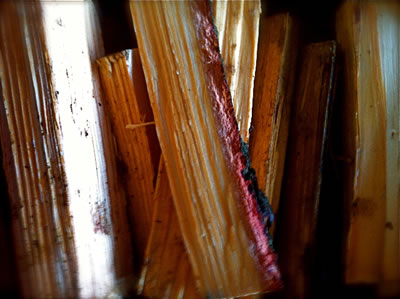
To the wood, the physical practice of chopping wood is the distinction from the hard, and blood scenting brace of cold iron — the blade of the ax — to the splitting wet of the wood that is new, and just fallen.
And older timbers, that have lain, warmed and dried over time — the sound and meditation is about the nature of the arcing swing, and the split, just so.
There are others woods that are fungi-tinted, and smell of the deepest forest — cutting them, the blade slides into the wood, and the moisture expresses from the grain, run vertical — looking up at you.
When you swing the ax — even if this might be in the wrist flick of the gripped gesture, the precision meets sound, cracking — and the burst of scent that comes out.
I cut four grains of wood — the pitch-burst hemlock, the old maple, the orange-barked madrona, the cedar, western red — and in each, I can hear that sound, each, another interpretation — and each, a varying scent as to where they’ve been, and from whence they are born.
As I make a fire, in the old stove — peering in, through the glass — getting the right piece in play, burning just right, the pitch heats up, the bark blackens, and I get it on my hands.
I can smell the taste of the cold iron of the axe blade, the oaken handle, the resins of the wood, and the burnt edge of the fire — all combined, making one profound scent.
The ancient fire — a maker, wood cutter, forest rover — carries that back: the smell of smoke together, glinting spark and the tar of trees, smeared in the memory of mind.
Tim
….
GIRVIN | THE GLINT OF FIRE
B R A N D E X P E R I E N C E >
http://www.girvin.com/blog/?cat=8